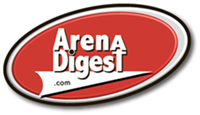When the Detroit Pistons open the 2017-2018 NBA season at Little Caesars Arena, it will be another chapter in the team’s fascinating arena history—an almost-80-year journey that saw stops at high-school gyms, college facilities and NFL stadiums.
By all accounts, Little Caesars Arena is a major step forward in the art of arena design, and it will be interesting to see how a Pistons game does in an arena primarily designed for hockey. In terms of the team’s history, Little Caesars Arena is light years away from the team’s early days playing out of a high-school gym. To understand these roots, we need to go back to the team’s roots in Duluth, Fort Wayne and industrial leagues.
Most casual fans know the roots of the Pistons name, originating as the Fort Wayne Zollner Pistons. Before Fort Wayne came Duluth (MN) and the creation of the Zollner Manufacturing Company in 1912. Then, as now, Duluth was known for its machinists, and the Zollner firm supplied parts for automobiles, heavy equipment and Iron Range mining machinery—particularly industrial-grade pistons. But the renamed Zollner Machine Works outgrew Duluth and, after a nationwide search, settled on Fort Wayne as a home to be centrally located to suppliers and customers.
As Zollner Machine Works grew over the next decades, so did the Zollner family’s interest in sponsoring employee sports programs. That was not uncommon, as you found industrial leagues in many sports, including baseball, softball and basketball. In the case of Zollner Machine Works, it meant competing against other industrial-league and semi-pro teams, both in tournaments and at home. By 1941 Fred Zollner was ready to take the next step and formally joined the National Basketball League, which included several corporate squads: Akron Goodyear Wingfoot, Indianapolis Kautskys (sponsored by a local grocery store) and the Toledo Jim White Chevrolets. And when the NBA emerged after a merger of the NBL and the Basketball Association of America in 1949, the Zollner Pistons had a seat at the table.
In those early NBL days, the Zollner Pistons played out of Fort Wayne’s North Side High School Gym. But the Fort Wayne Pistons outgrew that 3,000-seat high-school gym (which was later repurposed into a library, still standing), and the team’s success led to the construction of Allen County War Memorial Coliseum in 1952. Seating over 10,000 for basketball, Allen County War Memorial Coliseum also hosted pro hockey (indeed, the original Fort Wayne Komets launched in the IHL in 1952, though the present Komets franchise dates back only to 1990) and still is a community resource, hosting the aforementioned Komets as well as G-League basketball.
By 1957, Zollner realized the NBA was outgrowing Fort Wayne, and so came to the move to the open Detroit market. That led to a new home in the Olympia as a tenant of the Red Wings, with the University of Detroit’s Memorial Building (now known as Calihan Hall, still the college’s home court) used when there were scheduling conflicts. And while Allen County War Memorial Coliseum may have been too small for the growing NBA, the 15,000-seat Olympia may have been too big for the Detroit Pistons. In 1961 the team moved to the new, smaller 12,000-seat Cobo Arena (which still stands, albeit absorbed into the Cobo Center convention space), playing there through 1978. The smaller venue suited the Pistons well for many years. And Fred Zollner, whose roots were in that machine shop in Duluth working with his father, finally sold the team to Bill Davidson in 1974.
The NBA underwent another growth spurt in the late 1970s, though, and the Pistons rode that growth to another unique venue, the Pontiac Silverdome, where the team played from 1978 to 1988. The Silverdome was built for the NFL’s Detroit Lions, but there have been plenty of instances of NBA teams playing out of large venues: the Minnesota Timberwolves at the Metrodome, the New Orleans Jazz at the Superdome, the Seattle SuperSonics at the Kingdome. The roots of the Bad Boys era of Pistons basketball came at the Silverdome, before the team’s move to The Palace of Auburn Hills in 1988.
Along the way the Pistons also played some games at Joe Louis Arena in 1984 playoffs and the remainder of the 1984-1985 season after a March 4, 1985 snowstorm caused a tear in the Silverdome roof.
The Palace of Auburn Hills was considered state of the art in 1988, a $90-million facility originally featuring 180 suites. The Pistons were a hot draw during the Palace’s early days, selling out 259 straight games, but in the past few years the crowds have thinned and the Pistons were in the bottom five in NBA attendance. And with Little Caesars Arena expected to lure big-time concerts downtown, the writing was on the wall for the Palace. Hence Pistons owner Tom Gores buying into the new downtown Detroit arena and all the additional potential business.
This article originally appeared in the weekly Arena Digest newsletter. Are you a subscriber? Click here to sign up for the free weekly newsletter


